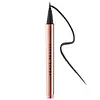Fenty Beauty Flyliner Longwear Liquid Eyeliner Versus r.e.m. beauty At The Borderline Eyeliner Marker
What's inside
What's inside
 Benefits
Benefits

 Concerns
Concerns

 Ingredients Side-by-side
Ingredients Side-by-side

Water
Skin ConditioningButylene Glycol
HumectantStyrene/Acrylates Copolymer
Acrylates Copolymer
Styrene/Acrylates/Ammonium Methacrylate Copolymer
Beheneth-30
CleansingPentylene Glycol
Skin ConditioningAlcohol
AntimicrobialCaprylyl Glycol
Emollient1,2-Hexanediol
Skin ConditioningEthylhexylglycerin
Skin ConditioningSodium Laureth-12 Sulfate
CleansingDisodium EDTA
C11-15 Pareth-7
EmulsifyingTetrasodium EDTA
Phenoxyethanol
PreservativeSodium Dehydroacetate
PreservativePotassium Sorbate
PreservativeCI 77266
Cosmetic ColorantWater, Butylene Glycol, Styrene/Acrylates Copolymer, Acrylates Copolymer, Styrene/Acrylates/Ammonium Methacrylate Copolymer, Beheneth-30, Pentylene Glycol, Alcohol, Caprylyl Glycol, 1,2-Hexanediol, Ethylhexylglycerin, Sodium Laureth-12 Sulfate, Disodium EDTA, C11-15 Pareth-7, Tetrasodium EDTA, Phenoxyethanol, Sodium Dehydroacetate, Potassium Sorbate, CI 77266
Water
Skin ConditioningAcrylates Copolymer
Butylene Glycol
HumectantAlcohol Denat.
Antimicrobial1,2-Hexanediol
Skin ConditioningBeheneth-30
CleansingGlycerin
HumectantPentylene Glycol
Skin ConditioningTromethamine
BufferingAcrylates/Octylacrylamide Copolymer
Sodium Polyaspartate
HumectantPhenoxyethanol
PreservativeCaprylyl Glycol
EmollientDisodium EDTA
Sodium Hydroxide
BufferingEthylhexylglycerin
Skin ConditioningCI 77510
Cosmetic ColorantIngredients Explained
These ingredients are found in both products.
Ingredients higher up in an ingredient list are typically present in a larger amount.
1,2-Hexanediol is a synthetic liquid and another multi-functional powerhouse.
It is a:
- Humectant, drawing moisture into the skin
- Emollient, helping to soften skin
- Solvent, dispersing and stabilizing formulas
- Preservative booster, enhancing the antimicrobial activity of other preservatives
Acrylates Copolymer is used as a film-forming agent and texture enhancer.
After applied, Acrylates Copolymer forms a thin film cover that helps skin feel more soft. It can help sunscreens become more water-resistant.
It is also used to make a product more thick.
Learn more about Acrylates CopolymerWe don't have a description for Beheneth-30 yet.
Butylene Glycol (or BG) is used within cosmetic products for a few different reasons:
Overall, Butylene Glycol is a safe and well-rounded ingredient that works well with other ingredients.
Though this ingredient works well with most skin types, some people with sensitive skin may experience a reaction such as allergic rashes, closed comedones, or itchiness.
Learn more about Butylene GlycolCaprylyl Glycol is a humectant and emollient, meaning it attracts and preserves moisture.
It is a common ingredient in many products, especially those designed to hydrate skin. The primary benefits are retaining moisture, skin softening, and promoting a healthy skin barrier.
Though Caprylyl Glycol is an alcohol derived from fatty acids, it is not the kind that can dry out skin.
This ingredient is also used as a preservative to extend the life of products. It has slight antimicrobial properties.
Learn more about Caprylyl GlycolDisodium EDTA plays a role in making products more stable by aiding other preservatives.
It is a chelating agent, meaning it neutralizes metal ions that may be found in a product.
Disodium EDTA is a salt of edetic acid and is found to be safe in cosmetic ingredients.
Learn more about Disodium EDTAEthylhexylglycerin (we can't pronounce this either) is commonly used as a preservative and skin softener. It is derived from glyceryl.
You might see Ethylhexylglycerin often paired with other preservatives such as phenoxyethanol. Ethylhexylglycerin has been found to increase the effectiveness of these other preservatives.
Pentylene glycol is typically used within a product to thicken it. It also adds a smooth, soft, and moisturizing feel to the product. It is naturally found in plants such as sugar beets.
The hydrophilic trait of Pentylene Glycol makes it a humectant. As a humectant, Pentylene Glycol helps draw moisture from the air to your skin. This can help keep your skin hydrated.
This property also makes Pentylene Glycol a great texture enhancer. It can also help thicken or stabilize a product.
Pentylene Glycol also acts as a mild preservative and helps to keep a product microbe-free.
Some people may experience mild eye and skin irritation from Pentylene Glycol. We always recommend speaking with a professional about using this ingredient in your routine.
Pentylene Glycol has a low molecular weight and is part of the 1,2-glycol family.
Learn more about Pentylene GlycolPhenoxyethanol is a preservative that has germicide, antimicrobial, and aromatic properties. Studies show that phenoxyethanol can prevent microbial growth. By itself, it has a scent that is similar to that of a rose.
It's often used in formulations along with Caprylyl Glycol to preserve the shelf life of products.
Water. It's the most common cosmetic ingredient of all. You'll usually see it at the top of ingredient lists, meaning that it makes up the largest part of the product.
So why is it so popular? Water most often acts as a solvent - this means that it helps dissolve other ingredients into the formulation.
You'll also recognize water as that liquid we all need to stay alive. If you see this, drink a glass of water. Stay hydrated!
Learn more about Water